Blood is a vital extracellular body fluid (fluid outside the cells). It is a fluid connective tissue and is also the softest tissue in the body. It is found in the body of vertebrates and some invertebrate also those which have developed circulatory system. Hence it is a fluid in the circulatory system that play many essential roles such as maintaining homeostasis, defence, transportations of nutrients, wastes, gases and many more. Let’s take a deep dive in blood, its composition, its functions, and various aspects.
Table of Contents
Why Blood is Vital?
Our life can not be sustained without blood. Every cell of our body requires oxygen and nutrients to sustain its life, and it is blood that assures their availability. All the life-sustaining biochemical reactions (metabolism) that occur in body cells require water, which is again made available by blood. Life is interplay of hundreds of complex processes which require coordination. Blood establishes coordination among various complex mechanisms, assuring different body organs such as brain, heart, kidney, liver etc., perform their functions effectively and efficiently by making available the right signals and essential metabolites to them. It play a vital role in removal of toxic wastes. Blood is vital. Perhaps because of this, we have been provided with a special mechanism of blood clotting, to prevent its loss.
COMPOSITION Of Blood
The fluid which runs in our arteries and veins has two components, the plasma, the fluid part and Formed elements, blood cells also called blood corpuscles.

Plasma
It is fluid part of blood. It is straw coloured, viscous, alkaline fluid.
Composition of Plasma
Water – 90-92%
Solid part – 8 – 10%
Solid part of plasma has Organic and inorganic part.
Protein Part (7-9%)
It include various type of proteins. All Plasma proteins are produced in liver except gamma globulins (produced by lymphoid organs)
1. Albumin (approx. 4%)
The most abundant protein, constitute 50% of total plasma protein and are produced in the liver. Although it performs many functions such as transportation of substances like fatty acids, steroids, antibiotics, hormones (e.g. thyroid hormones) and many more. But the most important function of it is to maintain Blood Colloidal Osmotic Pressure (BCOP), the pressure essential to pulls the interstitial fluid back into the capillaries.
2. Globulin (2-2.5%)
It is about 50% that of the total albumin in plasma. There are many types of globulins most of them are produced by liver while some by lymphoid organs. Some of the functions of globulin proteins are – act as enzymes, some act as immunoglobulins, some transport substances like iron copper etc.
There are 4 types of globulins in the plasma –
(i) α-1 Globulin
α-1 antitrypsin, a protease inhibitor, inhibit neutrophil elastase. Neutrophil elastases which are released by inflamed cells after cigarette smoking damage elastin proteins in the lungs.
(ii) α-2 Globulin
Ceruloplasmin, a copper carrying oxidase enzyme that may play role in oxidation of ferrous iron. Most of the copper in human body carried by ceruloplasmin.
iii) β Globulin
Group of proteins that carry substances such as iron. Transferrin (carry and transport iron), β-2 microglobulin (links with MHC class 1), properdin (play role in complement fixation) are some of the examples of β-globulins.
(iv) ү Globulin
They are immunoglobulin (antibodies) that destroy foreign substance such as pathogens toxins many more. There are 5 types of Immunoglobulins – IgA, IgD, IgE, IgG, IgM
Prothrombin (0.3%)
A protein produced by liver essential for blood clotting. Prothrombin is inactive form which activated into thrombin.
Fibrinogen (0.3%)
nactive proteins produced by liver which are soluble in plasma. Fibrinogen is converted into fibrin (insoluble) by thrombin. Fibrin forms clot.
Non-Protein Part (1-2%)
Nutrients – Nutrients in the plasma are Glucose, amino acids, Lipids etc.
Vitamins – Vitamin B and Vitamin C
Minerals – Na+, Ca+, Mg++, HCO3 –, Cl–
Nitrogenous Wastes – Urea, Uric acids, Ammonia, Creatine, Creatinineetc.
Dissolved Gases – Oxygen, Carbon Dioxide, and Nitrogen
Hormones – All endocrine glands secrete their hormones in the blood (thymosin secreted in lymph)
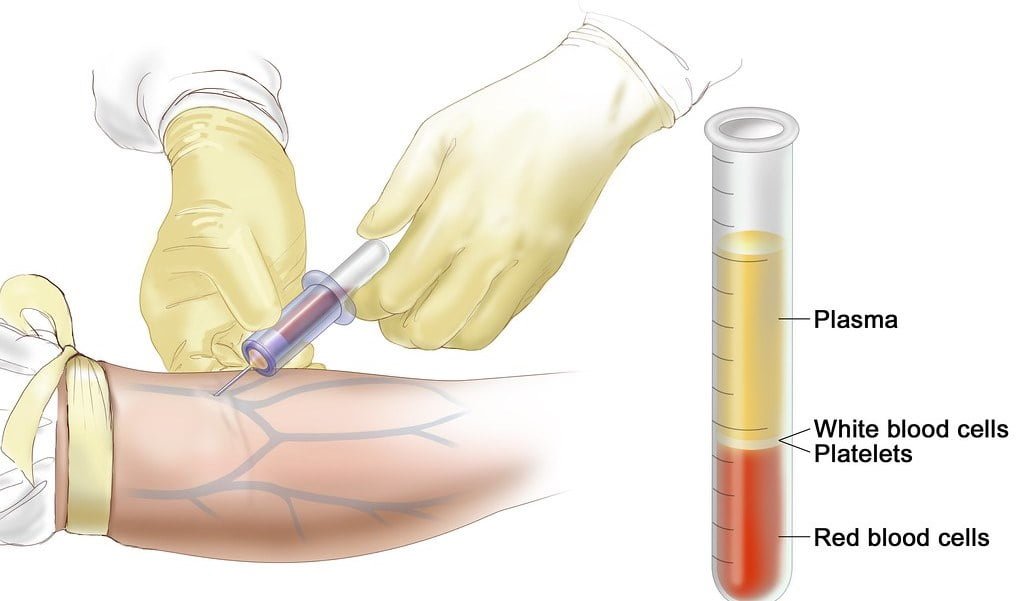
Formed Elements (Blood Cells)
There are 3 types of formed elements also called blood corpuscles or blood cells–
- Erythrocytes (RBC)
- Leucocytes (WBC)
- Thrombocytes (Platelets)
Erythrocytes (RBC)
Shape – In mammal RBCs are biconcave and discoid shaped.
They are oval and biconvex in Camel and Llama.
RBCs are non-nucleated in mammal. The nucleus and other cellular organelles degenerate during the course of maturation for the maximum accommodation of haemoglobin molecules.
Each erythrocyte contain about 250 – 270 million haemoglobin (Hb) molecules.
Erythrocyte count – The Total count of RBC of an Adult male is –4.7 to 5.8 million/mm3
While the total count of an Adultfemale is – 4.2 – 5.4 million/mm3
Erythrocytopenia – Decrease in RBC count
Polycythemia – Excessive rise in RBC count. Polycythaemia Vera is a type of blood cancer in which bone marrow produces too many RBC.
Haemoglobin Count –
Male:- 13.8 – 17.2 gm/100ml of blood
Female:- 11.5 – 15.5 gm/100ml of blood.
Size- Human Erythrocytes are 6.2 – 8.2 µm in diameter and 2 – 2.5 µm in thickness
Color- Erythrocytes are red in colour due to haemoglobin. But single erythrocyte appears pale yellow.
Structure- Immature RBCs in mammals have all the cellular organelles like mitochondria, Golgi bodies, Lysosomes, ER, etc. But in mature RBC they are absent including nucleus. RBCs are completely filled with haemoglobin molecules. Nearly 250-270 millions haemoglobin molecules are present in single RBC. Haemoglobin is an iron containing conjugate protein composed of 4 globin proteins conjugated with 4 non-protein ‘heme’ groups. Iron (Fe2+) present at the centre of heme group. Haemoglobin is responsible for the transportation of oxygen and CO2 hence play essential role in aerobic respiration in the body.
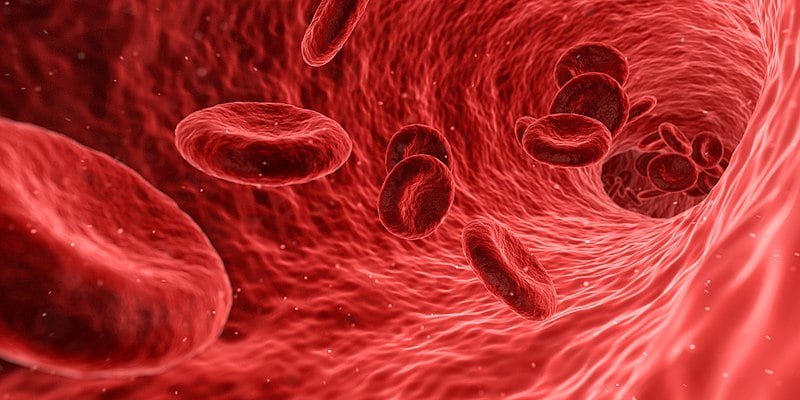
Erythropoiesis
Formation of Erythrocyte is called erythropoiesis. It begins during early embryonic development in –
Yolk Sac – 3rd to 8th week of gestation
Liver – 6th to 10th week of gestation
Spleen – 10th to 28th week of gestation
Bone marrow – 18th week onward (To adult)
Hematoblast cells of bone marrow give rise to RBC.
Substances essential for Erythropoiesis –
Iron – For Haemoglobin
Protein – For haemoglobin
Vitamin B12 – Essential for maturation of RBC
Folic Acid – Essential for maturation of RBC
Life span of RBC – 120 days
Spleen is said to be graveyard of RBC. When RBC become 120 days old it is removed from the circulation by spleen and destroyed.
Leucocytes (WBC)
Leucocytes are also called white blood corpuscles or WBC because the are colourless. They mostly play role in defence.
Numbers-
Total leucocyte count (TLC) – 6000 – 8000/ mm3 of blood
Ratio of WBC: RBC – 1:600
Rise in Leucocyte count – Leucocytosis
Excessive rise in Leucocyte count – Leukemia (Blood Cancer)
Decrease in WBC count – Leucocytopenia (often occur due to folic acid deficiency, malaria, tuberculosis, typhoid or viral infections)
Shape – Either round or irregular in shape. They have ability to change shape regularly hence, they are capable of amoeboid movement.
Size – 12 to 20 µm
Structure – They are true eukaryotic cellscontainingnucleus and other cellular organelles like mitochondria, Golgi bodies etc.
Types of WBC –

Granulocytes
Granulocytes are those WBCs in which cytoplasm appear granular due the
presence of proteins (enzymes that kill pathogens). Granulocytes are the
part of innate immunity and they have irregular or multi-lobed nucleus. There are 3 types of granulocytes
Neutrophils
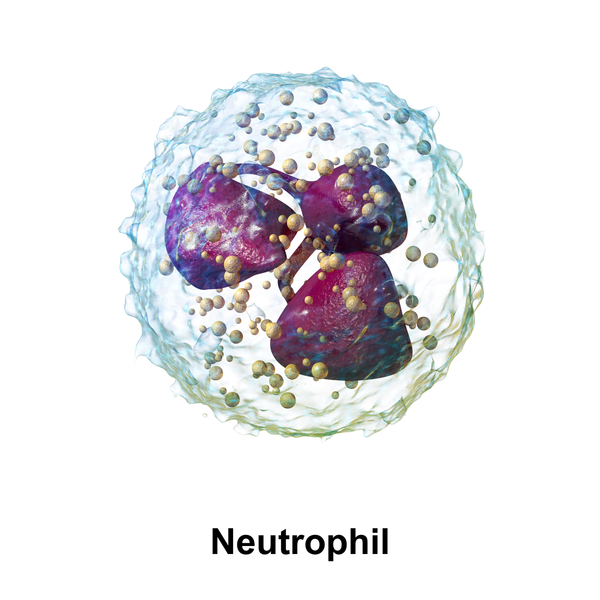
Neutrophils take neutral dye such as hematoxylin and eosin.
It has multilobed nucleus (3 to 5 lobes)
Neutrophils are most abundant WBC, constitute 40-70% of total WBC
They are most motile hence, reach first at the site of infection by amoeboid movement. They can carry out phagocytosis.
They are part of innate immunity, especially play role in acute inflammation.
They are short lived approximately 5 hours to 6 days.
Some neutrophils in female contain one inactivated X-chromosomes which is called ‘Barr bodies’ also called ‘Drum stick’ (sex chromatin)
Functions of Neutrophils:-
Neutrophis are part of innate immunity hence
it play role in immunity
Carry out phagocytosis meaning engulf pathogens like bacteria, protozoans etc.
Neutrophils perform ‘Chemotaxis’ Chemotaxis is movement in response to chemokines (chemical released by infected and damaged cells)
Eosinophils
They take acidic dye eosin hence called eosinophilss also called acidophils. They are 2-3% of total WBC
They have two-lobed nucleus
Their number rises during allergy.
They are part of immune system, attacks multicellular parasite (worms).
Basophils
They take basic dye such as methylene blue.
They are 0.5 – 1% of total WBC.
They have usually 3 lobed nucleus.
They are largest granulocytes
They are structurally and functionally similar to mast cells. Basophil play role in inflammation and mediate allergy. Basophils secrete three important chemicals-
- Histamine – It dilates blood vessels especially at the site of infection. It also mediates inflammation.
- Serotonin – It is vasoconstrictor, constrict blood vessels especially during rupturing of blood vessels
- Heparin – It is blood anticoagulant, prevent blood to clot. It is present all the time in the blood
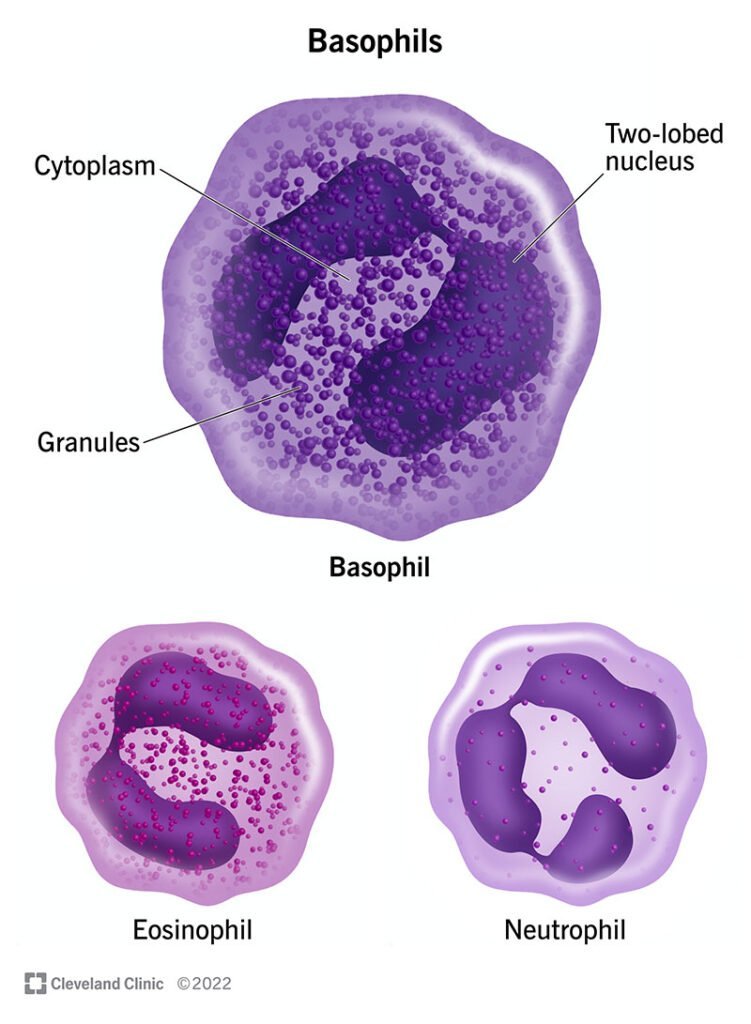
Agranulocytes
Granules in the cytoplasm are absent in agranulocytes. Nucleus does not divide into lobes. They are of two types – Monocytes and lymphocytes
Monocytes
Monocytes –
They are largest WBC with kidney shaped nucleus.
They are 2-10% of total WBC
They are irregular shaped and motile hence, carry out amoeboid movement.
They are phagocytic cells, engulf bacteria and cellular debrises.
They can squeeze out from the blood vessels and migrate to tissues, the process is called diapedesis. After migration the monocytes are now called macrophages.
Lymphocytes
They are smallest and second most abundant WBCs (20-25% of total WBCs).
They are non-motile and non-phagocytic.
They provide immunity to body, produce antibodies.
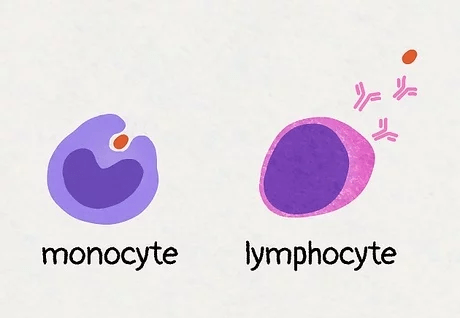
Normally their life span is 5-7 days. But some lymphocytes may live up to 30-40 year or more (Whole life) such as memory t-cells.
Lymphocytes are of two types – (i) B-lymphocytes (ii) T-lymphocytes
T-lymphocytes further classified into –
(i) T-helper cells
(ii) T-cytotoxic cells
(iii) T-suppressor cells
Thrombocytes (Platelets)
Thrombocytes are cell fragments produced from megakaryocytes of bone marrow. They are round, oval or disc like and are colourless. Nucleus and most of the cellular organelles are absent, only few are present such as mitochondria, lysosomes, peroxisomes etc.
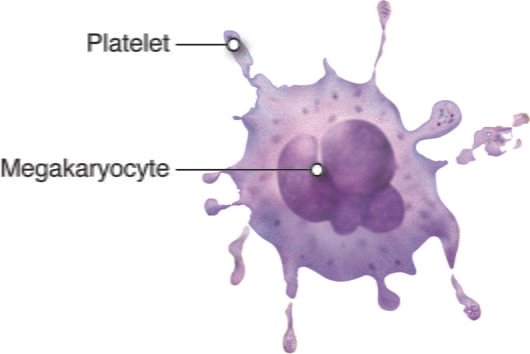
Platelets contain many chemicals most of them are involved in blood clotting. Some of the chemicals are Factor V, Factor VIII, Fibrinogen, fibrinonectin, PDGF, Ca+, serotonin etc.
Platelet Count – 1.5 – 3.5 lac/µl of blood
Increase in platelets count is called – Thrombocytosis
Decrease in platelets count is called – Thrombocytopenia
Thrombocytopenia is often leads to excessive blood loss (clotting disorder). In dengue platelet count become low because of dengue virus that attack and damage platelets.
Functions of Blood
- Blood transports food materials (nutrients) from intestine to every cells of the body.
- It transports oxygen from lungs to tissues and carbon dioxide from tissues to lungs.
- Blood carries hormones from endocrine glands to target cells as all the hormones are secreted in blood.
- Blood play crucial role in removal of wastes transporting it from tissues to excretory organs.
